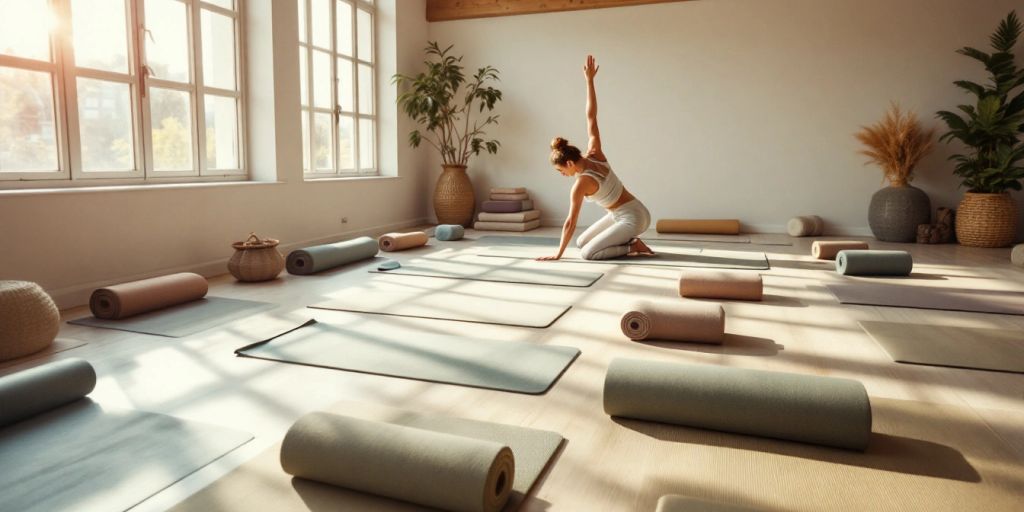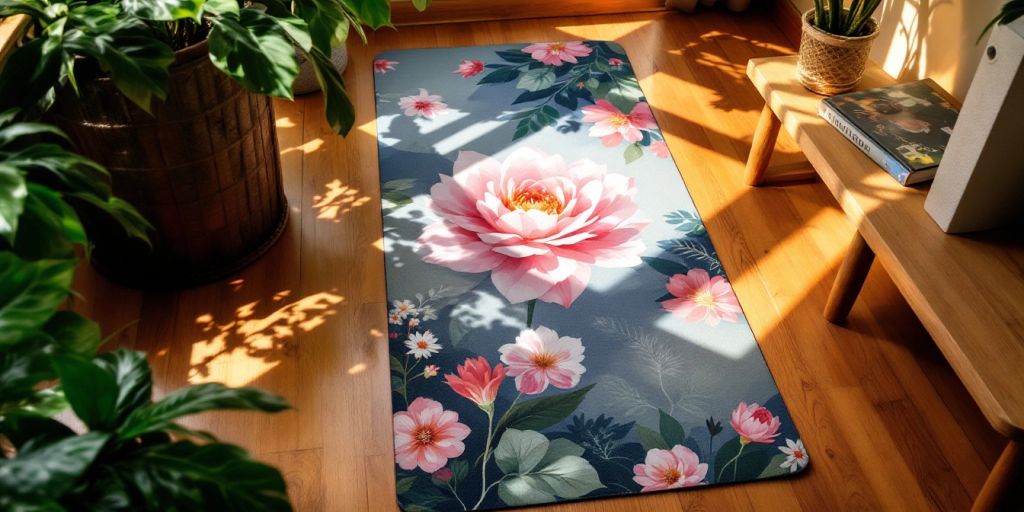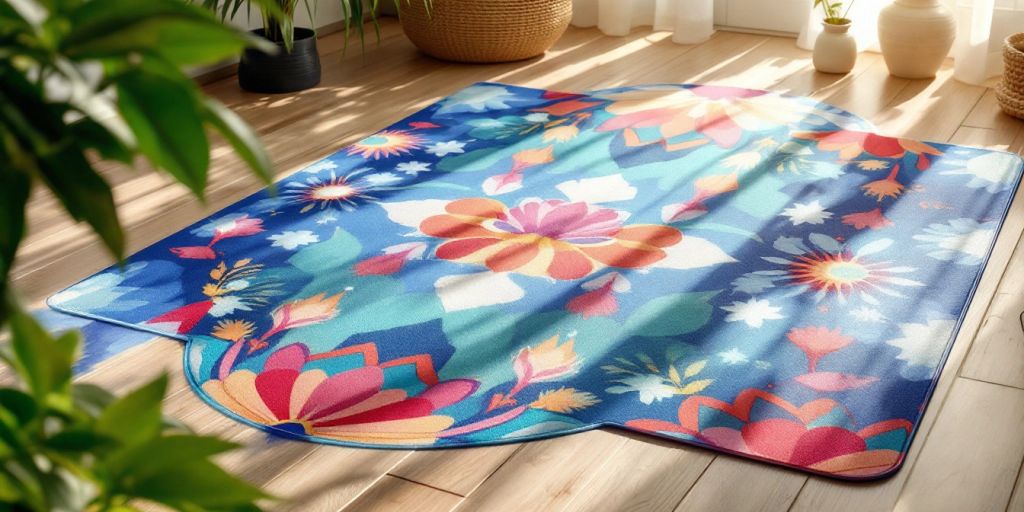
Finding the Perfect Balance: The Ideal Yoga Mat Thickness for Every Yogi
Choosing the right yoga mat thickness is essential for enhancing your practice and ensuring comfort. With various options available, understanding how thickness impacts your experience can help you make an informed decision. This guide covers the key aspects of yoga mat thickness, helping you find the perfect fit for your needs and preferences.
Key Takeaways
- The thickness of a yoga mat is crucial for comfort and stability during practice.
- Different yoga styles require different mat thicknesses for optimal performance.
- Material choice affects a mat's durability, grip, and eco-friendliness.
- Beginners should look for a medium thickness that balances cushioning and stability.
- Proper care and maintenance can extend the life of your yoga mat.
Understanding the Importance of Yoga Mat Thickness
When practicing yoga, the thickness of your mat can significantly impact your experience. Here’s why it matters:
How Thickness Affects Comfort
- A thicker mat provides more cushioning, which can help reduce strain on the knees, elbows, hips, and spine during poses.
- It can enhance comfort, especially during floor-based exercises.
- However, too much cushioning might make it harder to maintain balance in standing poses.
The Role of Thickness in Stability
- Stability is crucial for effective practice. A thinner mat can offer better connection to the ground, which is essential for balance.
- For dynamic styles like Vinyasa, a thinner mat is often preferred to maintain stability during transitions.
- Conversely, thicker mats are better for slower practices, providing the necessary support.
Impact on Joint Protection
- For those with sensitive joints, a thicker mat can be a lifesaver, offering the cushioning needed to protect against discomfort.
- However, it’s important to find a balance; too much cushioning can lead to instability in poses.
- Consider your personal needs and the type of yoga you practice when choosing the right thickness.
Remember, the right thickness can enhance your yoga experience, making it more enjoyable and supportive for your body.
Choosing the Right Thickness for Your Yoga Style
Best Thickness for Vinyasa and Ashtanga
For dynamic practices like Vinyasa and Ashtanga, a thinner mat (around 3-4mm) is often recommended. This thickness helps maintain balance and stability during transitions and standing poses. A thinner mat allows you to feel more connected to the ground, which is essential for these fast-paced styles.
Ideal Mats for Yin and Restorative Yoga
In contrast, for slower-paced styles such as Yin or Restorative yoga, a thicker mat (around 6mm) provides extra cushioning. This added thickness is beneficial for holding poses for longer periods, offering comfort and support to your joints.
Balancing Cushioning and Stability
When choosing a mat, consider the following:
- Joint Sensitivity: If you have sensitive joints, opt for a thicker mat for better cushioning.
- Practice Style: Match the mat thickness to your yoga style for optimal performance.
- Portability: Thinner mats are easier to carry, making them ideal for yogis on the go.
| Yoga Style | Recommended Thickness |
|---|---|
| Vinyasa/Ashtanga | 3-4mm |
| Yin/Restorative | 6mm |
Finding the right thickness for your yoga mat is essential for enhancing your practice. Choose wisely based on your style and needs!
Material Considerations for Yoga Mats
When selecting a yoga mat, choosing the right material is essential for comfort and performance. Different materials offer unique benefits, and understanding these can help you find the perfect mat for your practice.
Natural Rubber Mats
- Eco-friendly: Made from natural sources, these mats are biodegradable.
- Excellent grip: They provide a firm surface, ideal for various yoga styles.
- Heavier: They may be less portable due to their weight.
PVC and TPE Options
- Durability: PVC mats are known for their long-lasting nature.
- Affordability: Generally, these mats are budget-friendly.
- Sticky surface: PVC mats help prevent slipping, while TPE is lighter and more eco-friendly.
Eco-Friendly Alternatives
- Cork and Jute: These materials are biodegradable and often free from harmful chemicals.
- Organic Cotton: Soft and absorbent, perfect for those who prefer a gentle touch.
- Sustainability: Ideal for environmentally conscious yogis.
The material you choose will impact not only your comfort but also the mat's performance and longevity. It's important to consider how each material aligns with your personal needs and the type of yoga you practice.
| Material Type | Grip Level | Cushioning | Eco-Friendliness |
|---|---|---|---|
| Natural Rubber | High | Moderate | High |
| PVC | Moderate | High | Low |
| TPE | Moderate | Moderate | Moderate |
| Cork/Jute | High | Low | High |
Special Considerations for Different Practitioners

Beginners' Needs
When starting yoga, comfort is key. Beginners often benefit from a mat that is thicker, around 4mm, to help cushion their joints and provide stability. Here are some important points for beginners:
- Look for mats with good grip to prevent slipping.
- A thicker mat can help with balance during poses.
- Choose a lightweight mat for easy transport.
Advanced Practitioners' Preferences
Advanced yogis usually prefer a mat that balances cushioning and stability. They often choose mats that are around 4mm thick, which is just right for most practitioners. Here are some top picks:
| Mat Name | Thickness | Best For |
|---|---|---|
| The B Mat | 4mm | Hot Yoga |
| Ashtanga Pro Mat | 3.5mm | Dynamic Ashtanga |
| Vinyasa Grip Mat | 4mm | Flow Sequences |
Considerations for Joint Sensitivity
For those with joint sensitivity, a thicker mat can provide extra cushioning. Here are some tips:
- Choose a mat with a thickness of at least 5mm for better support.
- Look for materials that offer both cushioning and grip.
- Always consult with a yoga instructor if you have specific concerns.
Remember, the best mat is one that fits your personal practice and comfort needs. Experimenting with different thicknesses can help you find what works best for you!
Maintaining and Caring for Your Yoga Mat
Keeping your yoga mat in good shape is essential for a great practice. Regular cleaning and proper storage can extend its life. Here are some tips to help you maintain your mat:
Cleaning Tips for Longevity
- Wipe down your mat with a damp cloth after each use to remove sweat and dirt.
- For a deeper clean, mix mild dish soap with water and gently scrub the mat. This helps gently remove grime and oils.
- Always let your mat air dry completely before rolling it up to prevent mold and mildew.
Proper Storage Solutions
- Roll your mat loosely to avoid creases and maintain its shape.
- Store it in a cool, dry place away from direct sunlight and heat sources.
- If possible, use a yoga mat bag for added protection and easy transport.
Ensuring Hygiene and Safety
- Regularly check your mat for signs of wear, such as tears or a smooth surface that reduces traction.
- If your mat no longer feels supportive or your joints are feeling strain, it might be time for a new one.
Taking good care of your yoga mat not only extends its life but also ensures a safe and enjoyable practice every time.
Portability and Storage of Yoga Mats
When it comes to yoga mats, finding the right balance between comfort and convenience is key, especially for those who travel often. Mats that are about 1/16 inch thick are perfect for folding into a suitcase or strapping onto a backpack. However, thicker mats can be bulkier and require more space for storage.
Travel-Friendly Mat Options
- Lightweight mats are easier to carry.
- Foldable mats can fit in small bags.
- Compact designs save space.
Storage Solutions for Home and Studio
To keep your yoga mat in good shape, consider these storage tips:
- Roll your mat loosely to avoid creases.
- Store it in a cool, dry place away from direct sunlight.
- Use a yoga mat bag or strap for easier handling.
Balancing Portability with Comfort
While thickness is important, remember to choose a mat that fits your size and comfort needs. A thicker mat may offer more cushioning but can be harder to transport.
A well-maintained yoga mat can be a long-term companion on your wellness journey. Regular cleaning, combined with proper storage, will ensure that your mat remains hygienic, supportive, and inviting for every session.
Environmental Impact and Sustainability

Biodegradable and Recyclable Mats
When choosing a yoga mat, consider its environmental impact. Many mats are made from materials that can harm the planet. Here are some eco-friendly options:
- Natural Rubber: Biodegradable and provides excellent grip.
- Jute: A sustainable option with a unique texture.
- Cork: Antimicrobial and eco-friendly.
Sustainable Production Processes
The way mats are made also matters. Look for brands that prioritize:
- Sustainable sourcing of materials.
- Low-impact manufacturing processes.
- Fair labor practices.
Longevity and Durability
A mat that lasts longer is better for the environment. Consider these points:
- Durability: Choose mats that withstand wear and tear.
- Maintenance: Easy-to-clean mats last longer.
- Recyclability: Check if the mat can be recycled at the end of its life.
Choosing an eco-friendly yoga mat not only supports your practice but also helps protect our planet. Eco yoga mats are made from sustainable materials that are better for the planet. They often use natural resources like natural rubber, which is biodegradable.
Conclusion
Choosing the right thickness for your yoga mat is more than just a personal choice; it plays a key role in how comfortable and stable you feel during your practice. In this article, we looked at different mat thicknesses, their advantages, and how they fit various yoga styles and personal needs. Whether you are just starting out or have been practicing for years, knowing about mat thickness can help you make a smart choice that enhances your yoga experience. Always think about factors like cushioning, how easy it is to carry, and how long the mat will last to find the best fit for your yoga journey. In the end, the perfect yoga mat is one that feels good under your feet, helps you stay balanced in your poses, and matches your goals for your practice.
Frequently Asked Questions
What thickness of yoga mat is best for beginners?
Beginners usually benefit from a medium thickness mat, around 1/4 inch, as it offers a good mix of comfort and stability.
How does a thicker mat affect my practice?
A thicker mat gives more cushioning, which is helpful for your joints, but it might make it harder to balance.
Are there travel-friendly yoga mats?
Yes, thinner mats, often around 1/16 inch thick, are great for travel because they are lightweight and easy to pack.
What materials should I look for in a yoga mat?
Natural rubber, PVC, and eco-friendly options like cork or jute are popular choices, depending on your needs and values.
How do I keep my yoga mat clean?
Regularly wipe down your mat with a gentle cleaner and store it in a cool, dry place to keep it in good shape.
Can the thickness of my mat help with joint pain?
Yes, using a thicker mat can provide more support for sensitive joints, making your practice more comfortable.


